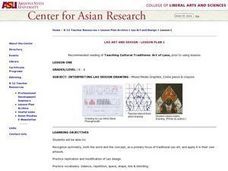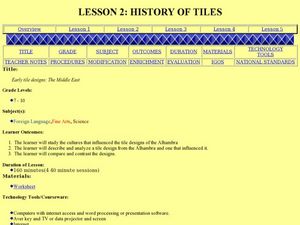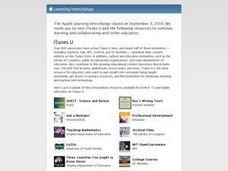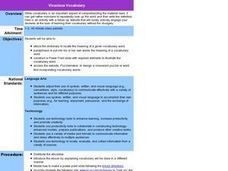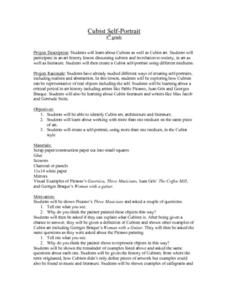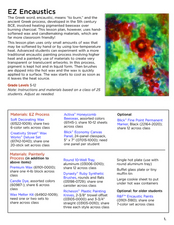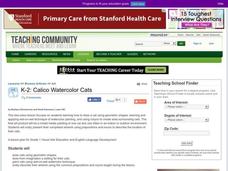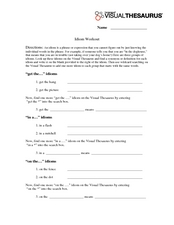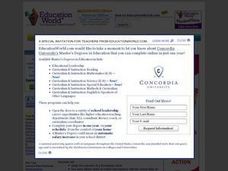Curated OER
Warhol and Collaboration
Students view images of Warhol/Basquiat collaboration and discuss them using the questions listed in the instructional activity. They work in groups to choose a theme or topic relating to American culture and discuss ideas about symbols...
Curated OER
Peace Posters
Young scholars focus on a theme to create a poster or collage. In this theme based art project, students communicate their peace theme through drawings to communicate their present feeling and ideas. Young scholars learn the emotions...
Curated OER
Five Quick Games Build Reading Skills
Build reading skills with these five quick games! Whether you're hoping to build grammar, syllabication, or word recognition skills, this resource has options for you. Kids will love taking a break from the mundane to play these...
Curated OER
Treasure Hunters
Students design an on campus treasure hunt to find various architectural vocabulary words which they then create definitions for on the blog page on the Environmental Design website.
Curated OER
Weaving Traditions - Activity 1
Students practice the techniques of weaving and braiding in this introductory lesson on family traditions and visual art. The lesson includes a video and other resource links.
Curated OER
Interpreting Lao Design Drawing
Students identify symmetry as a word and concept using drawings. The activity is cross-cultural using traditional Lao Art. The goal is to then apply the skills of symmetry to personal works of art that are produced.
Curated OER
Illustrating Student Writing in Grades 1-3
Students depict story elements in a visual medium, exhibit creativity through the completion of the drawn image, and practice computer skills. They use Microsoft Word to write about who they would like to meet, using Microsoft Paint they...
Curated OER
History of Tiles: Early Tile Designs - The Middle East
Students create a presentation on Middle Eastern art. In this art history lesson, students will research Middle Eastern art, specifically focusing on the Alhambra Palace and Moorish-inspired tile design. They will use information...
Curated OER
Image as Metaphor
A Dorothea Lange photograph launches this study of metaphors. Using the questions provided, the class examines the image and the title to consider how Lange uses her photo as a metaphor. Class members then select an object they can use...
Curated OER
Reflections on the Self - Self Portrait
Students produce their own self-portraits and use them to create a book in iPhoto. They explore the visual symbols used by artists to communicate their feelings, interests, and identity.
Curated OER
Vivacious Vocabulary
Pupils practice looking up the definitions of words using a dictionary. They put the defintion of the word into their own words. They create a PowerPoint slideshow to show illustrations related to their vocabulary words. Using the...
Curated OER
Using Context Clues
Teach your third graders how to find the meanings of words using context clues. Using this reading lesson, discuss how readers can find the meaning of a word by using the sentences around it. They then complete a worksheet in which they...
Curated OER
Cubist Self-Portrait
Study Cubism and Cubist art by examining a number of images with your students. They look at the relationship of Cubism to society architecture, and literature. Finally, they design a Cubist self-portrait using a variety of mediums after...
Curated OER
Figurative Language in Toni Morrison's "A Mercy"
In order to read and respond to Toni Morrison's A Mercy in this figurative-language lesson, students discuss the differences between a literal and a figurative interpretation of a text. They explore figures of speech using a...
Curated OER
Maus I and II: Pictionary
Why is visual literacy so important in understanding Maus? Introduce your class to basic elements of graphic novels with a game of pictionary. A list of 13 words are included, but you could potentially add some World War II-related...
Curated OER
Give Me A Museum and I'll Fill It
Third graders view pieces of Pablo Picasso's art. They discover art can have images and words to express meaning. They create their own piece of art and share with the class.
Curated OER
Journalism: Bullying Research
Students, after conducting extensive research about bullying, assemble their information into written and visual presentations. They write articles, conduct surveys, and develop infographics and other visuals.
Curated OER
EZ Encaustics
Have your class design a piece of art work using a canvas panel and wax. Learners employ a Greek process of art design popular in the fifth century to create their works. This is a great way to incorporate history into an art lesson.
Curated OER
Calico Watercolor Cats
A fun art project, this activity incorporates math and listening skills as young artists play with a new painting technique. First the teacher models how to draw a cat using shapes, an oval for the body, triangles for the ears and so on,...
Curated OER
Idiom Workout
Teach your students that identifying a phrase as an idiom isn't an insult! Providing an ample definition of the term "idiom," as well as three categories of popular idioms ("get the..." "in a..." and "on the..."), the activity prompts...
Curated OER
Give My Regards to Broadway
Students investigate aspects of Broadway shows. They apply word attack skills to decide what the titles of actual Broadway shows mean. They discuss the history of Broadway shows and why they become successful before completing the...
Curated OER
Dancing through Poetry
Get your class up and moving as they explore how to express movement and dance through words. Designed around two poems by Lillian Morrison about break dancing, the activity truly captures the creative and multi-sensory aspects of...
DK Publishing
Sentences #2 Worksheet
As your scholars learn how to read, it's important they understand that sentences are made up of words. For this visual worksheet, they count the words in two simple sentences and record the numbers. Each five-word sentence also has a...
Curated OER
"Jabberwocky": Inferring
Pupils, over an extended time, read and explain the nonsense words of Lewis Carroll's poem, "Jabberwocky". They infer the meaning of the poem using visualizing as well as decoding skills. While written for first graders, this is easily...







